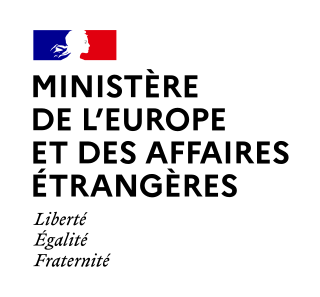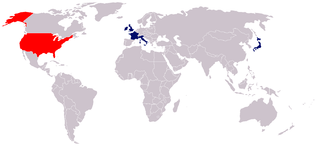Background
Orpen was one of the first people chosen as a war artist by the British Ministry of Information in 1917. Orpen was also the official painter at the peace conference and was commissioned to paint three canvases to record the proceedings. The work was the most expensive of the British public art commissions associated with the First World War: Orpen was paid £3,000; by comparison, John Singer Sargent received £300 for his much larger painting Gassed .
The painting depicts the signature of the Treaty of Versailles by representatives from Germany on 28 June 1919 that formally ended the First World War. The group portrait depicts soldiers, diplomats and politicians who attended the conference while the treaty was signed in the opulent surroundings of Louis XIV's Hall of Mirrors at the Palace of Versailles. High up can be seen the words "Le Roy Gouverne par lui meme" (French: "The King governs alone"). It measures 152.4 × 127 centimetres (60.0 × 50.0 in).
Orpen grew to dislike the politicians at the conference and considered them vain and greedy. In his painting, they are dwarfed by the scale of the palace.

The Treaty of Versailles was a peace treaty signed on 28 June 1919. As the most important treaty of World War I, it ended the state of war between Germany and most of the Allied Powers. It was signed in the Palace of Versailles, exactly five years after the assassination of Archduke Franz Ferdinand, which led to the war. The other Central Powers on the German side signed separate treaties. The United States never ratified the Versailles treaty and made a separate peace treaty with Germany. Although the armistice of 11 November 1918 ended the actual fighting, it took six months of Allied negotiations at the Paris Peace Conference to conclude the peace treaty. Germany was not allowed to participate in the negotiations; it was forced to sign the final treaty.

Georges Benjamin Clemenceau was a French statesman who served as Prime Minister of France from 1906 to 1909 and again from 1917 until 1920. A key figure of the Independent Radicals, he was a strong advocate of separation of church and state, amnesty of the Communards exiled to New Caledonia, as well as opposition to colonisation. Clemenceau, a physician turned journalist, played a central role in the politics of the Third Republic.

The Fourteen Points was a statement of principles for peace that was to be used for peace negotiations in order to end World War I. The principles were outlined in a January 8, 1918 speech on war aims and peace terms to the United States Congress by President Woodrow Wilson. However, his main Allied colleagues were skeptical of the applicability of Wilsonian idealism.

Peacemakers: The Paris Peace Conference of 1919 and Its Attempt to End War (2001) is a historical narrative about the events of the Paris Peace Conference of 1919. It was written by the Canadian historian Margaret MacMillan with a foreword by the American diplomat Richard Holbrooke. The book has also been published under the titles Paris 1919: Six Months That Changed the World and Peacemakers: Six Months That Changed the World.

The Ministry for Europe and Foreign Affairs is the ministry of the Government of France that handles France's foreign relations. Since 1855, its headquarters have been located at 37 Quai d'Orsay, close to the National Assembly. The term Quai d'Orsay is often used as a metonym for the ministry. Its cabinet minister, the Minister of Europe and Foreign Affairs is responsible for the foreign relations of France. The current officeholder, Catherine Colonna, was appointed in 2022.

The Paris Peace Conference was a set of formal and informal diplomatic meetings in 1919 and 1920 after the end of World War I, in which the victorious Allies set the peace terms for the defeated Central Powers. Dominated by the leaders of Britain, France, the United States and Italy, the talks resulted in five treaties that rearranged the maps of Europe and parts of Asia, Africa and the Pacific Islands, and also imposed financial penalties. Germany, Austria-Hungary, Turkey and the other losing nations were not given a voice in the deliberations; this later gave rise to political resentments that lasted for decades. The arrangements made by this conference are considered one of the great watersheds of 20th-century geopolitical history.
Events from the year 1920 in France.

Major Sir William Newenham Montague Orpen, was an Irish artist who worked mainly in London. Orpen was a fine draughtsman and a popular, commercially successful painter of portraits for the well-to-do in Edwardian society, though many of his most striking paintings are self-portraits.
The Supreme War Council was a central command based in Versailles that coordinated the military strategy of the principal Allies of World War I: Britain, France, Italy, the United States, and Japan. It was founded in 1917 after the Russian Revolution and with Russia's withdrawal as an ally imminent. The council served as a second source of advice for civilian leadership, a forum for preliminary discussions of potential armistice terms, later for peace treaty settlement conditions, and it was succeeded by the Conference of Ambassadors in 1920.

The Conference of Ambassadors of the Principal Allied and Associated Powers was an inter-allied organization of the Entente in the period following the end of World War I. Formed in Paris in January 1920 it became a successor of the Supreme War Council and was later on de facto incorporated into the League of Nations as one of its governing bodies. It became less active after the Locarno Treaties of 1925 and formally ceased to exist in 1931 or 1935.

René Massigli was a French diplomat who played a leading role as a senior official at the Quai d'Orsay and was regarded as one of the leading French experts on Germany, which he greatly distrusted.
Events from the year 1919 in France.

The Big Four or the Four Nations refer to the four top Allied powers of World War I and their leaders who met at the Paris Peace Conference in January 1919. The Big Four is also known as the Council of Four. It was composed of Georges Clemenceau of France, David Lloyd George of the United Kingdom, Vittorio Emanuele Orlando of Italy, and Woodrow Wilson of the United States.

Statesmen of World War I is an oil on canvas painting by Sir James Guthrie, completed in 1930, shortly before Guthrie's death. It was commissioned by South African financier Sir Abraham Bailey, 1st Baronet to commemorate the politicians and statesmen of Britain and its Dominions who held office during the First World War. It was donated to the National Portrait Gallery in 1930, shortly after it was completed.

The United Kingdom declared war on Germany on Sunday 3 September 1939, two days after Germany invaded Poland. France also declared war on Germany later the same day.

A Peace Conference at the Quai d'Orsay is an oil-on-canvas painting by Irish artist William Orpen, completed in 1919. It was one of the paintings commissioned from Orpen to commemorate the Paris Peace Conference in 1919. The work is held by the Imperial War Museum in London.

To the Unknown British Soldier in France is an oil-on-canvas painting by Irish artist Sir William Orpen, exhibited in one state in 1923 and then modified in 1927. It was one of three paintings commissioned from Orpen to commemorate the Peace Conference at Versailles in 1919. The work is held by the Imperial War Museum in London.
Events from the year 1919 in Italy.

The Foreign policy of the Woodrow Wilson administration deals with American diplomacy, and political, economic, military, and cultural relationships with the rest of the world during the Presidency of Woodrow Wilson, 1913–1921. Although Wilson had no experience in foreign policy, he made all the major decisions, usually with the top advisor Edward M. House. His foreign policy was based on the messianic philosophical viewpoint wherein he imagined America had the utmost obligation to spread its principles while reflecting the 'truisms' of American thought.
The Central Syrian Committee was an organization active during after World War I, seeking the independence and the unity of Syria. It lobbied for an autonomous and indivisible Syria extending from the Taurus mountains to the Isthmus of Suez, and from the Mediterranean to the banks of the Euphrates and beyond. The movement did not consider Palestine as a separate political entity.

















